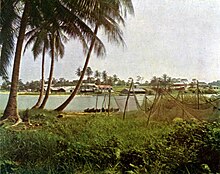Kribi
| Kribi | ||
|---|---|---|
|
|
||
| Coordinates | 2 ° 57 ' N , 9 ° 55' E | |
| Basic data | ||
| Country | Cameroon | |
| South | ||
| district | Océan | |
| ISO 3166-2 | CM-SU | |
| height | 13 m | |
| Residents | 60,000 (2007) | |
Kribi is a city in southern Cameroon at the mouth of the Kienkié on the Gulf of Guinea with around 60,000 inhabitants (2007). The residents are mostly Basaa , Batanga , Mabi, Ewondo and Bulu .
history
Kribi originated as a settlement of German merchants on the Batanga coast and belonged to the German colony of Cameroon since 1884 . In the following years it developed into the administrative and economic center of the south of the colony. In 1894 the Mecklenburg trainee was a. D. Dietrich von Oertzen was appointed district officer in Kribi, who had a small police force under a police master to carry out executive measures. Kribi soon became the main export port for rubber and ivory from the hinterland of the Batanga coast. In 1895 a customs office of its own was set up to make it easier for the merchants of the south to handle their export duties on site.
In 1899 the place was attacked by the Bulu pushing from the hinterland to the coast and had to be temporarily evacuated. The Bulu were subdued in 1899/1900 by the massive use of the military and established east of Kribi Station and Ebolowa District .
Economy and Infrastructure
The port (export of wood, cocoa and iron from inland South Cameroon) and tourism are of economic interest . The Kribi Container Terminal (KCT) with a total capacity of 1.4 million TEUs per year has been for 25 years at an operator consortium of the French shipping company CMA CGM , China's State China Harbor Engineering Corporation and Bolloré given.
Upon completion, the port is to become the largest deep-sea port in Central Africa. The project is financed 85 percent by the China Exim Bank and 15 percent by the state of Cameroon. It is hoped that the construction will relieve the port of Douala .
Kribi has one of the most beautiful beaches in Cameroon. A particularly worth seeing destination is the Lobé waterfall (Chute de Lobé) not far south of Kribi.
There are several hotels and a hospital in the city. The Catholic Pallottine Mission maintains a church that was built during the German colonial era and restored in 2002.
Climate table
|
Average monthly temperatures and rainfall for Kribi
Source: wetterkontor.de
|
|||||||||||||||||||||||||||||||||||||||||||||||||||||||||||||||||||||||||||||||||||||||||||||||||||||||||||||||||||||||||||||||||||||||
Trivia
In 1912, the biscuit manufacturer Bahlsen named a type of biscuit after this place.
Personalities
- Lauren Etame Mayer (* 1977), national soccer player born in Kribi
literature
- Horst v. Merhart, Gerhard Schneider: The restoration of the Pallottine Church in Kribi , in: Bulletin of the traditional association of former protection and overseas troops , Friends of the former German Protected Areas eV, 89 (1/2003), pp. 123-130.
gallery
Web links
- Data on Kribi at Falling Rain Genomics (English)
- Official website Kribi (French)
- L'annuaire internet de Kribi (in French.)
Individual evidence
- ↑ Wolfhart Fabarius: Regional hub for West Africa . In: Daily port report of September 2, 2015, p. 13
- ↑ Julius Schenkel, Qian Sun: Kribi: One city, one port, two worlds. In: Deutsche Welle . January 3, 2018, accessed October 28, 2018 .
- ↑ Reiner Meyer: The advertising art of the Bahlsen biscuit factory in Hanover from 1889-1945 . Münster 1999, p. 147








